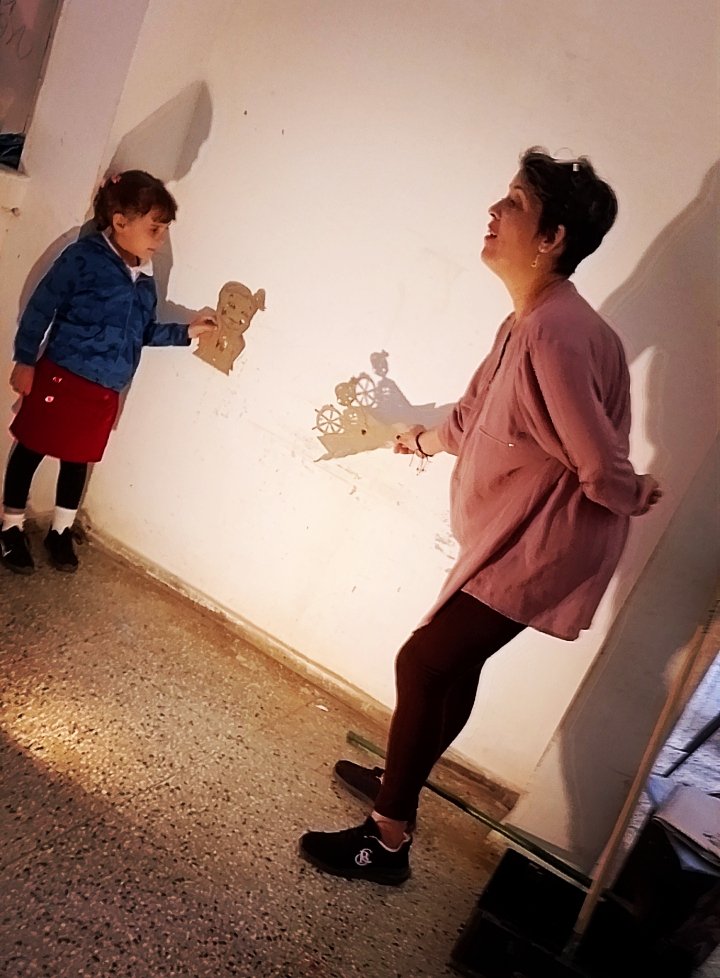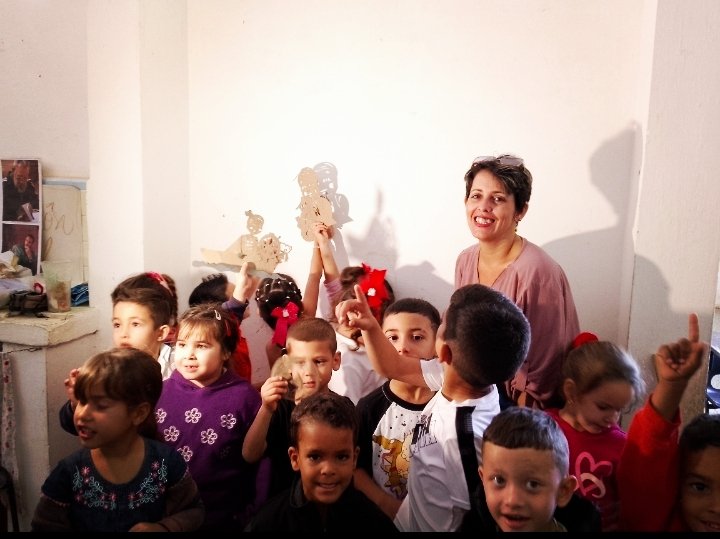
Hello, shadow lovers !!!
I greet you with this post that will be my entry to Shadow Contest and I also propose some ideas about the scope of the shadow in art, specifically in the theater of figures.
As the theater designer and puppeteer, I specialize in lighting design and the shadow is my favorite resource when narrating.
The shadow in the scene has discounted with a particular symbolic load and content.It has given such a fruit that one of its aspects points to the exclusive use of its aesthetic potential, a core condition that gives rise to the theater of shadows of the East, a heritage manifestation of universal art.
Modern man synthesized all possible types of shadow theatrical expressions in a more comprehensive and common denomination: Chinese shadows (Chinese Shadows, Chinese ombres, Ombri Cinesi, Chinese-Shattens, Chinese Hat).
For every form, theater recreates concerns, desires, dreams. Represented according to their genres, it is robbing or participates critically but always invites the confrontation of humanity with itself.The art of representation with shadows qualifies within the doll or puppet theater and in correspondence also observes the conventions and traditions that nourish him from the vast oriental culture.A "modified figure" is the puppet that is used because its technique offers the necessary mobility.The actions and decorations are plagued by significant meanings that converge in the narration of epic, mysterious and fantastic events, with the educational background of propagating some of the norms and customs.In this way, puppets are presented as opaque, translucent colored or silhouettes.

Precisely, in China it is where the way of connecting, through fictional images, to living and deceased, this theme I make the criteria of several scholars and historians, highlighting the information of Dr. Ignacio J. Castillo.The common denominator of all the investigations consulted is that during the dynasty they have one of the emperors was the victim of a deep depression after his favorite wife died.To mitigate the pain of the sovereign one of the palace servants managed the means of rescuing the dead beloved.His initiative consisted of projecting the silhouette of the lady's profile on a fabric, in this way the imperial nights charged a more animated tone ... until human curiosity violated all agreement and the secret of such an artifice was revealed.This art was quickly spread, it was admitted as a female entertainment object inside the private rooms because other theatrical variants were banned from the woman.
Subsequently, the stories told by the shadows were popular taste extending to every corner and social sector.He was known since then as the opera of the common man.Although supported by millenary invoice mechanisms, the Chinese shadow theater reaches the present without variations in consideration in its technical principles.

Every spectacle of this type relies on the use of a white silk or linen screen, a tensioned and fixed piece to the surface of a table that also supports the figures when they do not participate in the action.It lights with oil lamps or with electric light.To execute the work, the figures cut on the screen are pressed using three fundamental rods: paths for the upper extremities that guarantee the continuity and delicacy of the movements and the main or “rod of life” to plant the silhouette.The expressiveness also strengthened in the interpretive skill of its three manipulators
From the representation of the Wayang of Indonesia or the Turkish show of Karagöz, the taste for the "Chinese Shadow" spread more and more through Europe.Once the total skill was reached in their billing, there was a special care to cover up the origin of the movement.The illusion achieved was different because of the western system in a handling with rods from below.Victorian families made their delights at night with the theater of shadows until the invention of the magic flashlight.Punch and Judy shows shared moments of this artifice creating shadows of calicó and candlelight well known as "gallant shows."The French Drogillat, on the other hand, was moved to create useful items to seal their work style with the shadows: powerful light sources for better definition of the shade contour and projection at incredible distances, prisms for coloring the shadow, the multilumicolor to oversize opaque bodies and transparencies, the anáglifos (shadows to relief) to be seen with special glasses ...of all kinds.
From an early age it is common to find that charm of the shadow, as a narrative entity par excellence, in the game consisting of the interposition of the hands between a luminous source and the wall simulating some creature of the animal kingdom.

That is the basic principle of the representation with shadows and that also implies a mystical content of greater weight: link between life and death.
Within a conventions universe, now with ideological look, the shadow, according to the Spanish scholar Ignacio Javier Martinez de Olcoz, "... it will always be the unreal in relation to the real."Regardless of the context of its action, it means the concept of an existence dependent on what it is and is not.“The shadow, symbol of unreality and imperfect knowledge, refers to another instance of which it is mere announcement and degradation. Platonism underlined the first aspect, neoplatonism the second. Scholasticism ended up turning into the shade in the symbol of the symbol (…) the metaphor of what is not, the name of an absence, the name of an absence, the name of an absence, the name of an absence, the name of an absence is also confuses with the real."

I hope that reading has been interesting and I say goodbye by leaving them hugs of shadow and light.
To another post !!!
All rights over text and images belong to me
The banners were designed by me in Canva


Hola, amantes de la sombra!!!
Les saludo con este post que será mi entrada al Shadow Contest y además les propongo algunas ideas sobre los alcances de la sombra en el arte, específicamente en el teatro de figuras.
Como diseñadora teatral y titiritera, me especializo en diseño de iluminación y la sombra es mi recurso favorito a la hora de narrar.
La sombra en la escena ha discursado con una carga y contenido simbólico particular. Ha dado tal fruto que una de sus vertientes apunta hacia el empleo exclusivo de su potencial estético, condición medular que da origen al teatro de sombras del Oriente, manifestación patrimonial del Arte Universal.
El hombre moderno sintetizó todos los tipos posibles de expresiones teatrales con sombra en una denominación más abarcadora y común: sombras chinescas (chinese shadows, ombres chinoises, ombri cinesi, chinese-schattens, chinese sombreia).
Tanto para asiáticos como para occidentales el teatro recrea las preocupaciones, los anhelos, los sueños; representado según sus géneros, se regodea o participa críticamente pero siempre invita a la confrontación de la humanidad consigo misma. El arte de representación con sombras califica dentro del teatro de muñecos o de títeres y en correspondencia también observa las convenciones y tradiciones que le nutren de la vasta cultura oriental. Una “figura modificada” es el títere que se emplea pues su técnica ofrece la movilidad necesaria. Las acciones y decorados están plagados de significadosalegóricosque confluyen en la narración de los sucesos épicos, misteriosos y fantásticos, con el trasfondo educativo de propagar algunas de las normas y costumbres. De esta manera, las marionetas se presentan como figuras opacas, translúcidas coloreadas o siluetas.

Precisamente, en China es donde se desarrolla la forma de conectar, mediante las imágenes de ficción, a vivos y difuntos.Sobre esta temática hago propios lo criterios de varios estudiosos e historiadores, destacando las informacionesdel Dr. Ignacio J. Castillo. El común denominador de todas las investigaciones consultadas es de que durante la dinastía Han uno de los emperadores fue víctima de una profunda depresión tras fallecer su esposa favorita. Para mitigar el dolor del soberano uno de los sirvientes de palacio ingenió el medio de rescatar a la amada muerta. Su iniciativa consistió en proyectar sobre una tela la silueta recortada del perfil de la dama, de esta manera las noches imperiales cobraron un tono más animado…hasta que la curiosidad humana violó todo acuerdo y le fue revelado el secreto de semejante artificio. Rápidamente se difundió este artey se admitió como objeto de entretenimiento femenino en el interior de los aposentos privados pues otras variantes teatrales le estaban vedadas a la mujer.
Con posterioridad, las historias contadas por las sombras fueron de gusto popular extendiéndose a todo rincón y sector social. Se le conoció desde entonces como la ópera del hombre común. Aunque sustentado por mecanismos de factura milenaria el teatro de sombras chino llega al presente sin variaciones de consideración en sus principios técnicos.

Todo espectáculo de este tipo se apoya en el empleo de una pantalla de seda o lino blanco, una pieza tensada y fija a la superficie de una mesa que además sirve de apoyo a las figuras cuando no participan en la acción. La misma se ilumina con lámparas de aceite o con luz eléctrica. Para ejecutar la obra se presionan las figuras recortadas sobre la pantalla empleando tres varillas fundamentales: sendas para las extremidades superiores que garantizan la continuidad y delicadeza de los movimientos y la principal o “varilla de la vida” para plantar la silueta. La expresividad también se afianzaba en la destreza interpretativa de sus tres manipuladores.
De la representación del Wayang de indonesia o bien el espectáculo turco de Karagöz, el gusto por la “sombra chinesca” se fue diseminando más y más por Europa. Una vez alcanzada la total destreza en la facturación de las mismas, se tuvo el especial cuidado de encubrir el origen del movimiento. La ilusión lograda era diferente pues del sistema occidental en una manipulación con varillas desde abajo.
Las familias victorianas hacían sus delicias en las noches con el teatro de sombras hasta la invención de la linterna mágica. Los espectáculos de Punch y Judy compartieron momentos de este artificio creando sombras de calicó y luz de velas bien conocidos como “espectáculos galantes”. El francés Drouillat, por su parte, fue movido a crear artículos útiles para sellar su estilo de trabajo con las sombras: potentes fuentes de luz para mejor definición del contorno de la sombra y proyección a distancias increíbles, prismas para colorear la sombra, el multilumicolor para sobredimensionar cuerpos opacos y transparencias, los anáglifos (sombras a relieve) para ser vistos con gafas especiales… en fin, creaciones de todo tipo.
Desde edades tempranas es común hallar ese encanto de la sombra, como ente narrativo por excelencia, en el juego que consiste en la interposición de las manos entre una fuente luminosa y la pared simulando a alguna criatura del reino animal.

Ese es el principio básico del que se sustenta la representación con sombras y que además implica un contenido místico de mayor peso: nexo entre vida y muerte.
Dentro de un universo de convenciones, ahora con mirada ideológica, la sombra, al decir del estudioso español Ignacio Javier Martinez de Olcoz , “…será siempre lo irreal con relación a lo real”. Sin importar el contexto de su acción significa el concepto de una existencia dependiente de lo que es y no es. “La sombra, símbolo de irrealidad y conocimiento imperfecto, alude a su vez a otra instancia de la que es mero anuncio y degradación. El platonismo subrayó el primer aspecto, el neoplatonismo el segundo. La escolástica terminó convirtiendo a la sombra en el símbolo del símbolo (…) la metáfora de aquello que no es, el nombre de una ausencia, lo es también de lo que se confunde con lo real."

Espero que la lectura les haya resultado interesante y me despido dejándoles abrazos de sombra y luz.
Hasta otro post !!!
Todos los derechos sobre texto e imágenes me pertenecen
Los banners fueron diseñados por mí en Canva


